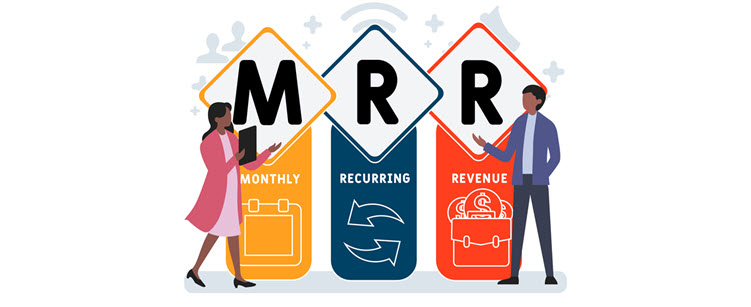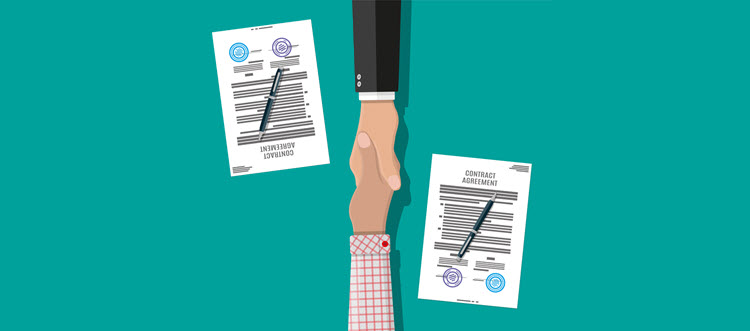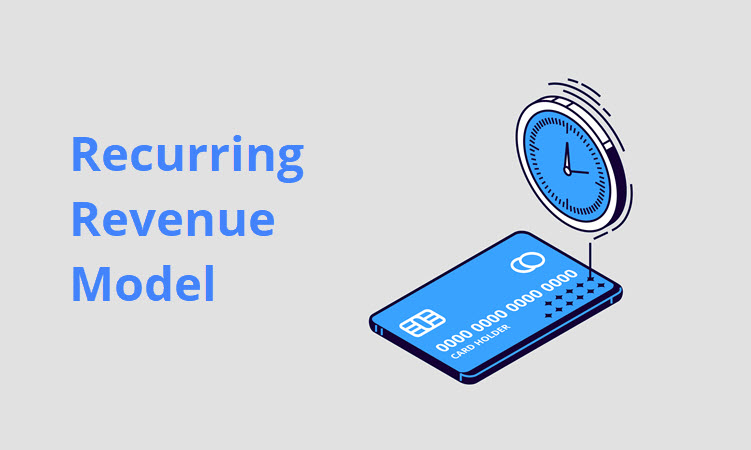Updated on August 4, 2022
Thanks to its predictable nature, recurring revenue provides major business advantages. It allows business planners to make recurring investments while keeping expenses stable and supporting a consistent cash flow.
Note: Refer to our article and learn how to forecast a recurring revenue.
However, not all businesses can support recurring revenue models. If your company sells one-of-a-kind custom items at a high price point, it is going to be difficult to generate recurring revenue. On the other hand, if you are selling mass-produced goods or content to the same group of customers, you will find it easier to set up a recurring subscription processing business model.
This article will help you understand what recurring revenue is, which subscription models work best in practice, and how you can leverage them to your advantage.
What Is a Recurring Revenue Model?

Recurring revenue is any repeating revenue that is distributed across regular intervals over a longer time span. In the recurring revenue model, the business receives payment as long as the customers don’t cancel their plan. The recurring revenue model is an established way of generating income for specific products, niches, and business types.
Revenue models are essential to a company’s entire business model and help determine how to convert customer value into profit. The most important consideration when choosing a revenue model is the target audience and overall strategy.
If you are a car dealer, you’re probably not going to sell a car to the same customer every month. But if you’re wholesaling coffee to bars and restaurants, you’re likely to sell consistent volumes to the same group of clients. This is recurring revenue in practice.
9 Types of Recurring Revenue Models
Recurring revenue is predictable by nature. The implementation of a recurring business model is where things get less predictable.
The key to making recurring revenue work is determining if the product you’re selling piecemeal at irregular intervals can be sold over time on a regular basis. This is where recurring revenue models come into play.
Below you can find nine typical recurring revenue models.
1. Subscription Membership

Subscription-based models are common in the publishing industry. A subscription provides recurring customers with new content each month. Digital publishing has pushed this idea further, so in addition to new releases, customers typically receive access to an archive of past publications.
Subscription-based businesses typically offer a tiered membership model to cover different customer segments. The basic subscription usually offers limited features and no customer support but is typically free of charge. Higher tiers offer expanded features and customer support with an increased price tag.
Online learning platforms are a classic example of subscription-based monetization. For a recurring fee, students gain access to learning materials (video lectures, articles, eBooks, etc.), live chat for student support, interactive lectures, and webinars.
If you are interested in the subscription industry, learn what you need to start a subscription business.
2. Sunk Money Consumables
Sunk money consumables are a recurring revenue model where a consumable is needed to keep a related product functional. For example, printers require ink to work, so companies must purchase ink cartridges regularly.
The way to leverage sunk money consumables is by manufacturing both the product that needs consumables as well as the consumables themselves.
What makes or breaks this model is how you define your consumables. For example, if a car manufacturer made tires that only lasted for a month, their customers would quickly switch to a different manufacturer.
3. Sunk Money Subscriptions
Sunk money subscriptions are another revenue model where a permanent purchase accompanies a recurring one. In this case, the recurrent aspect doesn’t come as an additional product but as a supplementary service required to make the original product or service work.
This model is common in the video game industry. After a one-time purchase of a game console, users need to subscribe to an online service. Through the online service, users purchase and play games, receive updates, and access multiplayer game servers.
4. Hard Contracts

Hard contracts are service-level agreements with strict conditions in terms of billing and services provided. In the hard contract model, services are provided to customers over a given period in exchange for charges set in advance. Hard contracts rely on legal force to set up recurring revenue.
Internet service providers typically rely on this model of recurring revenue. Once a customer signs a contract, they are eligible to receive internet access for a fixed period with a recurring monthly fee, possibly with limitations on bandwidth. The costs for breaking the contract are often substantial, so customers usually wait until their contract is up to renegotiate.
5. Auto-Renewal Subscriptions
Auto-renewal subscriptions rely on the fact that customers want a hassle-free experience. So instead of nudging the customer to renew their subscription at set intervals, the subscription gets renewed automatically, and revenue keeps rolling in.
Content distributors such as Netflix use auto-renewals to great effect. Netflix correctly assumes that once customers are hooked on a particular series or genre, they’ll want unrestricted access. Automatic payments are the perfect solution for this use case.
6. Online Membership Programs
Instead of relying on a single product or service for recurring revenue, you can sell a bundle of related services for a recurring fee. The advantage of this model is that you give customers multiple ways to extract value from your offer instead of forcing them to pick a single service.
The standard model is to create a membership website website where users access various features for a monthly or annual admission fee. Some users might gravitate toward networking with like-minded users in a safe environment, some might prefer browsing the knowledge base to find valuable data, and others might do a little bit of both in addition to using a free template or app provided on-site.
7. Freemium
The freemium model gives customers free access to the basic service while offering extra features to those who pay. The name freemium is a blend of the words free and premium, as the customer gets the product for free, but the company charges a premium for additional features.
Freemium services are a delicate balancing act. If you give the customers too little, they won’t get hooked on the service — if you give them too much, they won’t have a reason to buy it.
For example, music and video streaming platforms promise premium members an ad-free experience with higher-quality content. The video game industry uses its own blend of the freemium model called free-to-play. Players play the game for free but pay to access additional content or to obtain a competitive advantage over other players.
8. Per-User Billing Model
In the per-user billing model, customers are charged based on the number of people using the product or service. This model is predominantly used in the B2B ecommerce business model. The total fee scales linearly as the number of users increases, meaning the price is the same for every new user on the network.
Note: SaaS companies often use the per-user billing model paired with tiered pricing. Each tier supports a certain number of users. Higher tiers have lower per-user fees but require more users in total.
The main advantage of the per-user billing model is simplicity. Calculating the bill is as straightforward as counting the number of user accounts, making it easier to predict cash inflow and budget accordingly for the provider and customer. Additionally, customers don’t need to worry about hidden fees as each account provides full functionality.
Examples include Microsoft, which charges a fixed fee for every new Microsoft Teams user. Customer Relationship Management (CRM) software companies like Salesforce or Zoho also use this model to generate recurring revenue.
9. Hybrid model
You can also combine revenue models into a hybrid billing model. An example is Birchbox which combines a recurring and one-time purchase model, or Slack, which uses a per-use model combined with a tiered subscription.
Learn everything you need to know about Subscription vs Membership.
Advantages of Using a Recurring Revenue Model
There are many advantages to using a recurring revenue business model.
Consistent Cash Flow

Recurring revenue models allow you to predict your cash flow with greater precision, making it easier to plan and keep track of your finances as a business. You can make long-term investments without worrying about whether you’ll be able to meet monthly costs.
Safe Investment
The predictable nature of recurring revenue models attracts investors. Recurring revenue leads to stable growth over time, so investors are guaranteed to make a profit with minimal risk.
Customer Loyalty
Recurring revenue models support customer retention strategies, leading to more loyal followers. Once customers become accustomed to using your services, they will be reluctant to switch to another provider.
Disadvantages of Using a Recurring Revenue Model

Recurring revenue models have a number of unique disadvantages. While they are less obvious than the advantages, they are equally important.
Vulnerability to Technological Breakthroughs
Recurring revenue models assume that businesses can sell a given product or service continuously without compromising the value they provide to customers. But with new technologies, these models can quickly become obsolete.
If what you’re selling as a service can suddenly be replaced with a one-off purchase, customers will have no reason to use your solution.
Complacency
Recurring revenue is potentially harmful if it affects company culture and leads to complacency. If revenue just keeps rolling in, some organizations start neglecting customer service, product development, and other growth engines.
Customer Lock-in
Over time, recurring services lock-in a customer into an ecosystem. While that may be a good thing for you, the business providing the service, consider that customers may notice that they rely on your service too heavily. When that occurs, they will try to diversify and may move to a different platform altogether.
Recurring Revenue Model - Legal Considerations
Processing recurring payments requires you to adhere to certain rules and regulations. Below are some things you must consider when developing a recurring revenue business model.
Opt-In/Opt-Out Option
You must ensure full legal disclosure when signing customers up for auto-renewals. Otherwise, you expose the business to potentially 12 months of chargebacks if you haven’t properly secured the approval of the cardholder upfront.
Refunds
In case of service outages or part payments, your refund policy must be crystal clear before the cardholder signs up. You must have the right buy-in from the cardholder in advance.
Note: Learn about the differences and similarities between chargebacks and refunds and how to handle them in our article Chargebacks vs Refunds.
Conclusion
Recurring revenue is a remarkable asset for any business that can implement it. With the right product and a sound marketing plan, you can make the recurring revenue model work in many industries.
If you can transform your one-off sale into a long-term service, you are going to gain a lot of benefits from the recurring revenue.
